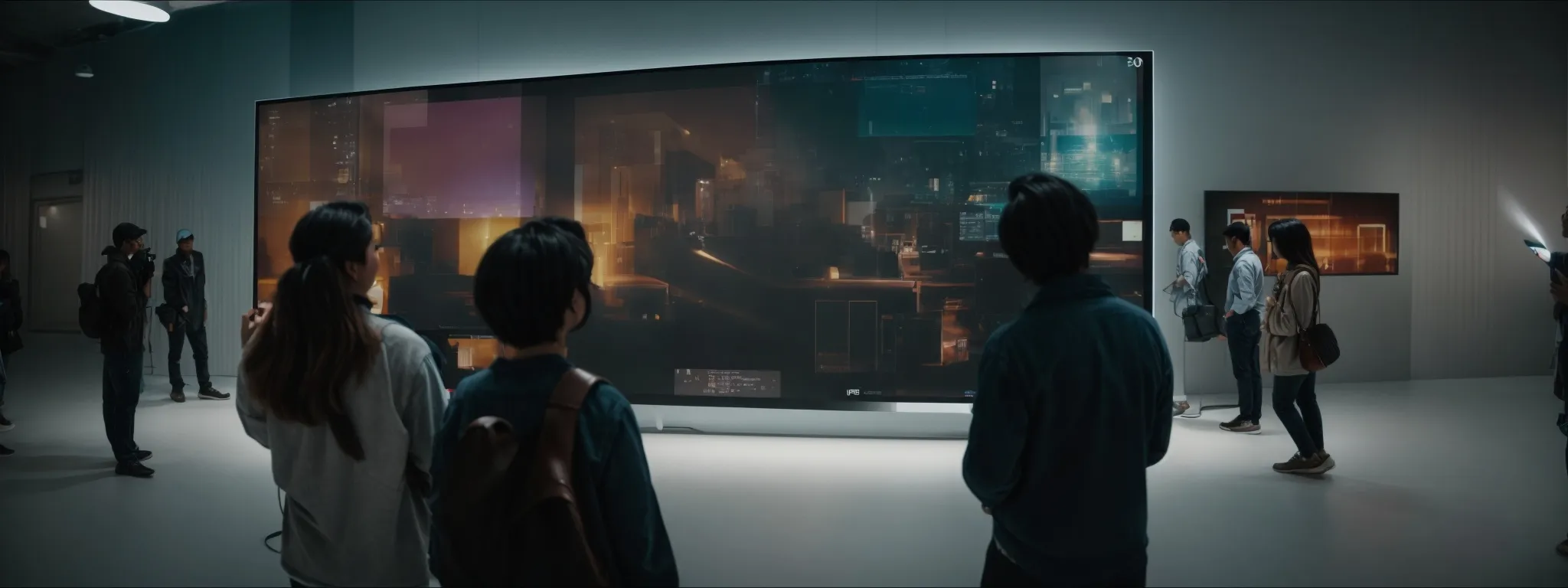On-Site SEO: Why Technical SEO is Rarely Enough
Beyond Technical SEO: The Importance of Comprehensive on-Site Optimization In a digital landscape where search engine optimization evolves with relentless pace, the distinction between technical prowess and […]
Beyond Technical SEO: The Importance of Comprehensive on-Site Optimization
In a digital landscape where search engine optimization evolves with relentless pace, the distinction between technical prowess and comprehensive on-site optimization has become significant.
Technical SEO lays the groundwork, but it’s the synergistic combination of intuitive site architecture, meticulously crafted content, and user-focused features that catapults a brand’s online presence to new heights.
Fusing these elements not only satisfies search algorithms but resonates profoundly with users, leading to higher engagement and conversion rates.
Optimizing for speed and mobile usage further ensures websites are not just discoverable, but also accessible and favored by those who navigate them.
Keep reading to discover how a holistic approach to SEO can transform your online footprint into a beacon for both search engines and consumers.
Key Takeaways
- On-Site SEO Extends Beyond Technical Elements to Prioritize User Experience and Content Quality
- Effective Site Optimization Includes Both Structural and Visual Strategies to Guide Users Seamlessly
- Rapid Page Loading and Mobile Optimization Are Indispensable for User Satisfaction and SEO Success
- Incorporating Multimedia and Optimizing for Performance Contribute to Engaging User Experiences and SEO Value
- User Engagement, Such as Social Sharing and User-Generated Content, Significantly Impacts SEO Outcomes
Exploring the Scope of on-Site SEO Beyond Technical Aspects

In the realm of search engine optimization, on-site SEO represents a critical facet that extends well beyond technical configurations and backend tinkering.
Businesses and marketers are increasingly recognizing the importance of harmonizing technical prowess with a tailored user experience, a synergy that is fundamental to boosting search engine rank.
While the bedrock principles of technical SEO—such as site speed, xml sitemaps, and schema implementation—remain non-negotiables for digital architects, the pivot towards emphasizing content quality underscores the evolving landscape.
High-value web content, which resonates with both user and search algorithm criteria, sets a new standard for site rank elevation, laser-focusing on the alignment of content strategy, user intent and engagement.
Understanding the Core Elements of on-Site SEO
The landscape of on-site SEO is a dynamic one, where the core elements encompass much more than just technical finesse. At its heart lies the need for an SEO content strategy that expertly caters to the nuances of user behavior and search query relevance, critical factors that search engines value when determining search rankings.
Amidst the intricacies of crafting fine-tuned web content, businesses must not overlook the power held by title tags, h1, and h2s in steering the efficacy of their SEO efforts. These components, although seemingly minute, play a pivotal role in how content is indexed and understood by search engines, thereby shaping the site’s visibility and user experience.
Balancing Technical SEO With User Experience
Within the digital landscape, balancing technical SEO with user experience necessitates a comprehensive approach, where developers and content creators collaborate seamlessly. Acknowledging the user as the focal point, this strategy involves refining site architecture and design to ensure intuitive navigation that aligns with search habits and preferences:
- Refinements in site infrastructure, including streamlined navigation and mobile responsiveness, cater to a better user experience.
- Customized content that targets user intent leads to increased engagement and lower bounce rates.
- Implementation of advanced technical SEO tactics ensures the site’s functionality supports its content-driven goals.
Concentrating on user experience may involve elevating page speed for swift content delivery, which in turn can reduce bounce rates and enhance overall satisfaction. Technical Adjustments and User-Focused Content integration establish a digital environment where both search engines and visitors ascertain value, thus driving organic traffic and improving search engine rank.
Prioritizing Content Quality in SEO Strategies
At the forefront of on-site SEO strategies, the premium placed on content quality cannot be overstated, as it remains a decisive factor for search engines and users alike. LinkGraph’s SEO services underscore this by integrating SEO content strategy with the intention to not only attract but to engage and convert visitors, resulting in a significant uplift in organic traffic and search autonomy.
Effective on-site optimization extends an invitation to search engines to rank a site higher due to the relevance and value of its content. LinkGraph leverages the prowess of the SearchAtlas SEO software to ensure that web content surpasses mere keyword integration, orientating every page to serve as a resource that addresses searcher intent with clarity and authority.
Enhancing User Engagement Through Intuitive Site Structure

The digital sphere is akin to a vast ocean, where the structure and organization of content can either anchor the user firmly on-page or cast them adrift amidst a sea of information.
Acknowledging the significance of this, professionals are turning a keen eye towards structured site design that steers user engagement through Seamless Navigation and Usability.
Indeed, the aptitude of a website to subtly guide visitors through internal linking and bring about a visual order that prioritizes pertinent content plays a critical role in enhancing user retention.
Within the ecosystem of on-site optimization, these components coalesce to create intuitive pathways that entice users to delve deeper, fostering an environment conducive to exploration and interaction.
Designing for Seamless Navigation and Usability
In an age where user attention spans are limited, the expertise of seasoned web developers in creating sites with easy navigation is paramount. Strategic placement of navigational elements and logical flow ensure that users find their desired information with minimal effort, bolstering both engagement and the potential for conversion.
Professionals at LinkGraph acknowledge that the usability of a website significantly influences visitor interactions, triggering positive user behavior metrics that search engines use to evaluate site quality. Through meticulous planning and design, they prioritize user pathways, making sure that every click advances the visitor’s journey towards the intended action or information.
Internal Linking to Keep Users Exploring
LinkGraph’s sophisticated approach to Site Optimization Places a significant emphasis on the strategic use of internal linking, a tool that serves as a silent navigator, continuously engaging users by providing paths to additional, relevant content. The subtlety with which these links are integrated into web pages is key—a seamless experience that never interrupts but rather enhances the user’s journey.
Utilizing internal links effectively, LinkGraph’s SEO experts craft each user’s exploration as an opportunity for discovery, gently guiding them through the website’s landscape to increase time spent on site, and fostering a deeper connection with the brand’s messaging. This tactic not only captivates the user but also strengthens link equity, cementing a robust link profile that is highly regarded by search engines.
The Role of Visual Hierarchy in User Retention
The judicious application of visual hierarchy is an influential factor in retaining a user’s interest. Through the deliberate orchestration of text size, color, and spacing, LinkGraph’s design experts magnify the significance of key website elements, ensuring they command attention and guide the user’s journey.
Strategic visual cues inform the user’s experience, subtly promoting sections of content that are crucial for conversion or further engagement: this visual hierarchy ensures that the most pertinent information catches the eye promptly and effectively.
- Key web content is made prominent through calculated visual cues.
- Strategic design elements are utilized to lead the user’s eye to areas of importance.
- Consistency in visual hierarchy across pages reinforces content structure, aiding in navigation.
Content Optimization Strategies That Complement Technical SEO

Embarking on the journey of on-site optimization entails diving into a melange of strategic elements that transcend the confines of a website’s technical framework.
The crafting of captivating meta titles and descriptions, the judicious deployment of header tags to sculpt a logical content hierarchy, and the infusion of astutely researched keywords into the fabric of content creation — these are the touchstones that complement the underlying technical prowess of a well-optimized site.
In a digital landscape where every on-page signal contributes to standing out in the vast expanse of search results, these practices form an integral part of a holistic approach to SEO.
LinkGraph’s SEO services expertly navigate this confluence of creativity and analytics to elevate the online presence of businesses, encompassing everything from crafting magnetic page titles to optimizing the very structure of information presented to both users and search engines.
Crafting Compelling Meta Titles and Descriptions
In the intricate world of on-site optimization, the significance of crafting compelling meta titles and descriptions cannot be overstated. These elements act as a storefront for every web page, providing a succinct preview in search results that can determine whether a user clicks through to the site, influencing both traffic and search engine rank.
LinkGraph’s on-page SEO services recognize the dual role meta titles and descriptions play in both appealing to users and satisfying search engine algorithms. They harness the capability of SearchAtlas SEO software to generate precise and attractive meta elements that encapsulate page essence while accommodating the key phrases essential for search visibility.
Utilizing Header Tags for Logical Content Flow
The intelligent application of header tags is essential for creating a logical content hierarchy that enhances readability and facilitates search engine crawling. Through meticulous construction of H1s, H2s, and successive subheadings, LinkGraph’s on-page SEO services ensure that content is neatly structured, enabling both search engines and users to follow a coherent narrative flow.
Incorporating header tags effectively bridges the gap between technical SEO and enriching user experience, guiding the reader through a narrative that is both informative and intuitively segmented. LinkGraph’s approach accentuates the critical role header tags play in signposting key sections of content, fundamentally improving the user’s journey and bolstering content discoverability.
Implementing Keyword Research in Content Creation
Keyword research is not just a fulcrum for SEO; it is the strategic foundation of content creation. LinkGraph employs robust keyword analysis, aligning content with the search patterns and needs of the target audience to ensure maximum visibility and engagement.
Before a single word is crafted, LinkGraph’s meticulous approach to keyword research sifts through data to discern terms and phrases that resonate with both the brand’s voice and search engine algorithms:
- Selection of keywords based on relevance, search volume, and competitive landscape.
- Integration of keywords into content so that they flow naturally within the narrative.
- Regular evaluation of keyword performance to refine and pivot strategies as necessary.
This targeted application of keyword insights fuels the creation of content that not only attracts but also retains user interest, optimizing the journey from search query to conversion.
The Critical Role of Page Speed and Mobile Optimization

In today’s fast-paced digital environment, the efficiency with which a website loads and its mobile responsiveness are not merely user conveniences—they are critical factors that directly affect search engine optimization.
Recognizing that page speed influences bounce rates, conversion rates, and crucially, search engine rank, professionals in the field of SEO are prioritizing swift load times as a cornerstone of a comprehensive on-site strategy.
Furthermore, with the growing predominance of mobile web browsing, creating a website that accommodates this shift has become an indispensable aspect of enhancing user experience and SEO performance.
This necessitates an array of tools and practices directed at optimizing page speed and ensuring mobile-friendliness to meet the rigorous demands of modern internet usage and search engine standards.
Assessing the Impact of Loading Times on SEO
In the analysis of a website’s SEO health, loading times are a benchmark for both user satisfaction and search engine rank. Search engines, recognizing the user’s preference for quick access to information, factor page speed into their algorithms, making load times a non-negotiable aspect of on-site optimization.
LinkGraph’s Advanced Technical SEO Audit places particular emphasis on measuring and optimizing page speeds to augment a site’s SEO performance and user retention. Fast-loading pages reduce bounce rates and enhance the user experience, signaling search engines to assign a higher rank to those websites:
- Comprehensive evaluation of current page loading times to identify potential bottlenecks.
- Implementation of site speed optimization strategies aimed at shortening load times and improving user engagement.
- Continuous monitoring of page speed performance to ensure alignment with SEO best practices and user expectations.
Approaches to Creating a Mobile-Friendly Website
The influx of mobile web usage mandates that websites not only adapt but thrive on various small screens. LinkGraph’s Mobile Optimization Services employ responsive design techniques to ensure that content fluidly adjusts to any device, maintaining usability and aesthetic integrity without sacrificing load speed or content accessibility.
Responsive design represents just one facet of mobile optimization; LinkGraph also focuses on the critical importance of touch-friendly interfaces and navigation menus. By prioritizing these elements that facilitate effortless interaction on touchscreens, they ensure a frictionless user experience that aids in retention and conversion rates:
| SEO Element | Mobile Optimization Strategy | Impact on User Experience |
|---|---|---|
| Responsive Design | Fluid content scaling for various devices | Consistent usability and visual appeal |
| Touch-friendly Interfaces | Intuitive touch controls for navigation | Enhanced ease of use for mobile users |
| Load Speed | Optimized images and streamlined code | Faster page loading, reduced bounce rates |
Tools and Practices for Improving Page Performance
Tools and methodologies for enhancing page performance are at the forefront of on-site optimization, where every millisecond of loading time is pivotal. LinkGraph fuses the latest technical SEO tools, such as code minification, compression, and browser caching, to refine and hone website speed, ensuring a swift, Streamlined User Journey from the initial page request to final content render.
Professionals at LinkGraph harness a variety of practices to ensure peak website performance; they implement responsive images and asynchronous loading of scripts to diminish unnecessary lag. Additionally, utilizing a Content Delivery Network (CDN) enhances the distribution of website assets, dramatically improving access times for users across different geographic locations:
| Performance Aspect | Optimization Tool/Practice | Effect on Page Performance |
|---|---|---|
| Server Response Time | CDN, optimized server configuration | Faster delivery of content to users globally |
| Resource Loading | Asynchronous script loading, compression | Efficient loading sequence, reduced page weight |
| Image Optimization | Responsive images, lazy loading techniques | Decreased initial load time, improved user experience |
Leveraging Multimedia Content for Comprehensive SEO

Amid the myriad facets of on-site optimization, multimedia content emerges as a powerful instrument to enrich the user experience and provide additional context for search engines.
A site that skillfully integrates images and videos stands to not only captivate its audience but also to fortify its SEO footprint.
Well-executed visual elements draw users into the narrative of the website, encouraging prolonged interaction while simultaneously offering search engines rich media signals to interpret.
The astute use of alt text and meticulous file optimization become cornerstones of an effective multimedia SEO strategy, bolstering both the accessibility and technical performance of a website’s diverse content offerings.
Boosting Engagement With Images and Videos
Images and videos possess an innate ability to captivate and engage, transforming the user’s interaction from mere browsing to an immersive experience. LinkGraph recognizes this and incorporates rich media with a focus on enhancing site dwell time and providing diverse content forms that cater to different preferences, leading to improved SEO outcomes.
By Strategically Embedding Multimedia Elements within website content, LinkGraph underscores their commitment to delivering a robust user experience that encapsulates not just textual information but also visual storytelling. These elements are optimized for quick loading and cross-device compatibility to ensure they augment rather than impair the user’s journey, bolstering both engagement and search engine optimization.
SEO Best Practices for Multimedia Elements
Incorporating multimedia correctly necessitates adherence to SEO best practices that enhance the discoverability and relevance of visual components. LinkGraph ensures that videos and images carry appropriate file names and alt attributes aligned with the content’s targeted keywords, positioning these assets to contribute positively to the page’s SEO profile.
LinkGraph’s expertise extends to recommending compression techniques and file format choices that maintain the integrity of multimedia content while optimizing for swift page load times, essential to maintaining a balance between visual richness and technical performance.
The Importance of Alt Text and File Optimization
In the endeavor to augment on-site optimization, the implementation of alt text and the optimization of file sizes are paramount. Alt text provides a textual alternative to images for search engines and visually impaired users, thereby improving accessibility and contributing to the SEO potency of multimedia content.
File optimization is an equally critical measure, as it involves compressing images and videos without degrading quality, ensuring that these assets enhance the user experience by reducing page load times, a key factor scrutinized by search engine algorithms.
Taking Advantage of Social Signals and User Interactions

In the orchestrating of on-site optimization strategies, the dynamism wrought by social signals and user interactions emerges as an influential component in bolstering SEO value.
LinkGraph’s holistic approach to SEO services meticulously cultivates an environment where social sharing is not merely incidental but a strategic instrument for amplification.
Moreover, the agency recognizes the untenable SEO potential of user-generated content and vigilantly quantifies the impact of user behavior metrics on search engine rankings.
This section untangles the interplay between social engagement, user contributions, and the resulting SEO benefits that can propel a website’s prominence in an increasingly interconnected digital landscape.
Encouraging Social Sharing to Boost SEO Value
LinkGraph understands that the confluence between social media and SEO is a potent force in today’s digital ecosystem. Encouraging social sharing acts as a multiplier of your content’s reach, amplifying visibility and signaling to search engines the value and relevance of your page content.
This social proof, curated through shared links, likes, and mentions, not only expands your audience but also contributes to backlink profiles. These social interactions are indicative of quality and user endorsement:
- Strategically placed social share buttons invite user engagement and facilitate content dissemination.
- User endorsements through social interactions increase backlink opportunities and enhance brand visibility.
- Analysis of social engagement metrics provides insightful data, enabling refined SEO strategies.
User-Generated Content as an SEO Asset
User-generated content, spanning from reviews to forum discussions, represents an untapped vein of SEO gold for brands like LinkGraph. This content not only enriches the site with fresh, unique material but also facilitates the incorporation of natural language and long-tail keywords which are critical to a diversified SEO strategy.
LinkGraph harnesses this enriching stream of content by promoting customer engagement across the digital platform, ensuring an organic growth of qualitative content that search engines favor. The inclusion of user reviews and community feedback creates a lively hub of activity that search engines interpret as a signal of relevance and authority.
| User Engagement Method | SEO Impact | LinkGraph’s Approach |
|---|---|---|
| Customer Reviews | Increase in Unique Content | Encouraging feedback submission |
| Community Discussions | Enhanced Keyword Diversity | Facilitating user interactions |
| Social Content Sharing | Improved Social Signals | Integrating share features |
Measuring the Impact of User Behaviors on Rankings
LinkGraph’s expansive SEO services vigilantly monitor and parse the nuanced yet critical impact of user behaviors on a website’s search engine rankings. Their analytics delve into the relationship between dwell time, click-through rates, and interactions on a page to forge a strong correlation between user experience and a site’s visibility in search engine results.
Professionals at LinkGraph understand that the subtleties of user engagement—from a comment on a blog post to the sharing of a product page—can serve as influential indicators to search engines, hinting at the authority and value of the site’s content. These behavioral data points contribute to refined algorithms, which appreciate and reward websites fostering robust user interaction with improved ranking potential.
Conclusion
In conclusion, comprehensive on-site optimization transcends the boundaries of technical SEO to create a harmonious user experience through the synergistic interplay of quality content, intuitive site structure, responsive design, and multimedia integration.
By crafting compelling meta descriptions, utilizing header tags, and leveraging rich media, businesses amplify user engagement and search engine visibility.
Prioritizing swift page speeds and mobile friendliness further enhances user satisfaction and adheres to search engine standards.
Additionally, harnessing social signals and facilitating user-generated content magnify the SEO value of a website.
Through the meticulous application of these strategies, LinkGraph and similar SEO experts ensure that websites not only meet technical benchmarks but also deliver a rich, engaging experience that drives organic traffic, fosters user interactions, and ultimately leads to higher search engine rankings.














































































